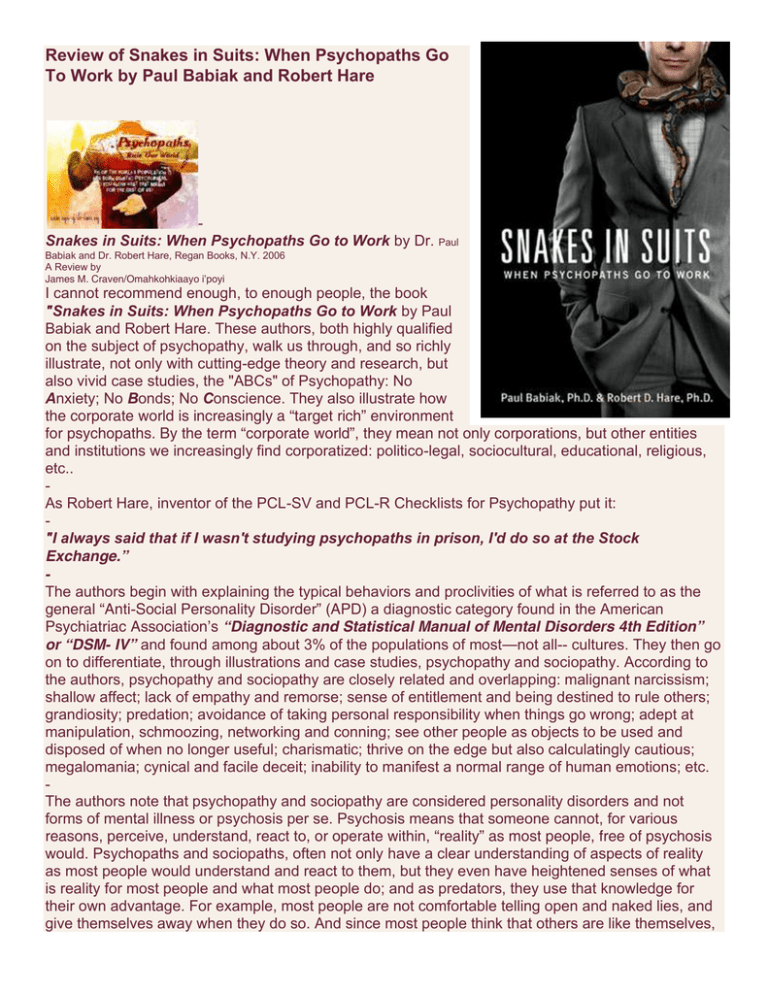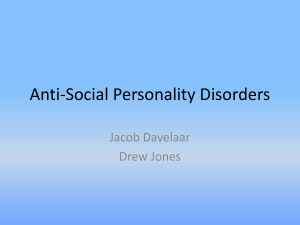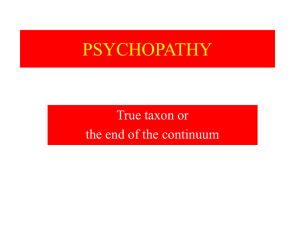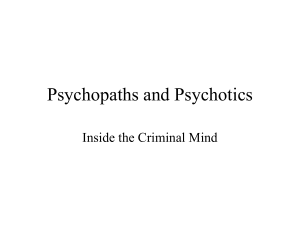Review of Snakes in Suits: When Psychopaths Go -
advertisement

Review of Snakes in Suits: When Psychopaths Go To Work by Paul Babiak and Robert Hare Snakes in Suits: When Psychopaths Go to Work by Dr. Paul Babiak and Dr. Robert Hare, Regan Books, N.Y. 2006 A Review by James M. Craven/Omahkohkiaayo i’poyi I cannot recommend enough, to enough people, the book "Snakes in Suits: When Psychopaths Go to Work by Paul Babiak and Robert Hare. These authors, both highly qualified on the subject of psychopathy, walk us through, and so richly illustrate, not only with cutting-edge theory and research, but also vivid case studies, the "ABCs" of Psychopathy: No Anxiety; No Bonds; No Conscience. They also illustrate how the corporate world is increasingly a “target rich” environment for psychopaths. By the term “corporate world”, they mean not only corporations, but other entities and institutions we increasingly find corporatized: politico-legal, sociocultural, educational, religious, etc.. As Robert Hare, inventor of the PCL-SV and PCL-R Checklists for Psychopathy put it: "I always said that if I wasn't studying psychopaths in prison, I'd do so at the Stock Exchange.” The authors begin with explaining the typical behaviors and proclivities of what is referred to as the general “Anti-Social Personality Disorder” (APD) a diagnostic category found in the American Psychiatriac Association’s “Diagnostic and Statistical Manual of Mental Disorders 4th Edition” or “DSM- IV” and found among about 3% of the populations of most—not all-- cultures. They then go on to differentiate, through illustrations and case studies, psychopathy and sociopathy. According to the authors, psychopathy and sociopathy are closely related and overlapping: malignant narcissism; shallow affect; lack of empathy and remorse; sense of entitlement and being destined to rule others; grandiosity; predation; avoidance of taking personal responsibility when things go wrong; adept at manipulation, schmoozing, networking and conning; see other people as objects to be used and disposed of when no longer useful; charismatic; thrive on the edge but also calculatingly cautious; megalomania; cynical and facile deceit; inability to manifest a normal range of human emotions; etc. The authors note that psychopathy and sociopathy are considered personality disorders and not forms of mental illness or psychosis per se. Psychosis means that someone cannot, for various reasons, perceive, understand, react to, or operate within, “reality” as most people, free of psychosis would. Psychopaths and sociopaths, often not only have a clear understanding of aspects of reality as most people would understand and react to them, but they even have heightened senses of what is reality for most people and what most people do; and as predators, they use that knowledge for their own advantage. For example, most people are not comfortable telling open and naked lies, and give themselves away when they do so. And since most people think that others are like themselves, when they encounter the absolute certitude, faked sincerity, and look-straight-into-your-eyes intensity of a psychopath or sociopath outright lying to them, or manipulating them, they typically react thinking, that, like themselves, no one could possibly be this certain and appear this sincere if they were lying; that is precisely what con artists, psychopaths and sociopaths are counting on. As Marx put it: "The secret of life is honesty and fair dealing. If you can fake that, you’ve got it made.” Groucho Marx, that is. Psychopaths may be distinguished from sociopaths in one fundamental respect. Whereas sociopaths have no allegiance to, and even contempt for, any values or rules or laws of a wider society beyond their own small sub-group, such as a gang or cult, psychopaths have no allegiance to anything transcendent beyond themselves. Within gangs and cults, at war with society, there are certain codes and sociopaths are capable of holding to forms of allegiance and adherence to transcendent— beyond the individual--values and rules at least of the sub-group. Psychopaths, are total and ultraindividualists and narcissists, and have no allegiances beyond themselves and their own notions of their own narrow and selfish interests. Both psychopaths and sociopaths may not only find the business world a “target-rich” environment, they also can find religious, non-profit, educational, legal, military and political organizations attractive as well. According to the authors, the corporate worlds (any organizations run like corporations), are increasingly a “target-rich” environments for psychopaths for four basic reasons: 1) Some core psychopathic personality traits (“talents”) may seem attractive in job applicants and get them hired; traits such as: assertiveness; ability to appear genuine when faking sincerity and honesty; ability to quickly assess vulnerabilities of people and manipulate them; shallow affect; take-charge narcissism; and expertise manipulating through schmoozing and networking; etc; 2) Superficial notions of effective management and “leadership” (focus on hierarchy; taking charge; exercise of top-down power and decision-making but with avoidance of accountability; etc) play right into the hands of psychopaths. Typical proclivities for megalomania, malignant narcissism, manipulation, intrigue and using/treating people as mere useful objects or instruments, may appear, to those themselves not real managers or leaders, or even to fellow psychopaths, as “decisive management”; and even “leadership”. Either like attracts like, or, those lacking substance, typically, are not willing to select for substance even if they could recognize it. 3) The changing nature and structures of businesses often favor psychopaths. As businesses become less hierarchical, more lean, more complex and more flat, and as businesses have to become increasingly flexible and agile, the devolution of power and accountability—or at least accountability—to what were “lower” levels of corporations, then, in such contexts, the “take-charge”, ruthless, demanding, manipulative and apparently “results-oriented” managers, often psychopaths, appear increasingly attractive to those at the top who want power and perks but not proportionate accountability on themselves. What appear to be “take-charge”, as well as “take-the-heat” types, sometimes psychopaths, appear to be perfect for those at the very top who want power and perks but not accountability. Of course, psychopaths typically do the same to those below them. 4) In the context of increasingly lean, complex and agile businesses and other institutions, the types of individuals who are willing to ignore “cumbersome” and “constraining” rules, laws, best practices in management, and, are ruthless and devoid of empathy, coupled with abilities to con and manipulate as well as “direct”, may be attractive in some fast-paced and ultra-competitive organizations. As Plato, one of the first recorded analysts of psychopathy (along with Lao-tze) put it: "Those who seek power are invariably the least fit to hold and wield it." Plato understood, perhaps instinctively, or perhaps from examples around him, that those who would self-anoint, self-proclaim, self-credential themselves as "leaders", to be parachuted "down" on and over, those they purport to "lead", demonstrate a certain level of hubris, absolute certainly, malignant narcissism and megalomania that is breathtaking and extremely dangerous. As an old Chinese aphorism goes: "Power is something a good person will not seek, and a bad person should not have." This book goes far beyond simply listing and illustrating the kinds of behaviors and proclivities that form the PCL-R or PCL-SV "Checklists of Psychopathy" devised by one of the authors, Dr. Robert Hare. It gives actual case studies, rich in details, that illustrate how psychopaths get hired, promoted, operate, and are ultimately caused to exit; either, because of their own ultimately self-revealing and self-impeaching behaviors, or, because they were finally exposed to the sunlight, accountability and transparency they eschew and even fear. As the authors show, psychopaths, like the toxic emotional vampires they are, fear daylight and transparency; they prefer the dark. They do not like to be taped. They do not like witnesses to conversations. They do not like sustained contact and exposure. They fear going to paper. They prefer to use surrogates for some of their intrigue. They can lie at the drop of a hat, and continue to lie, to try to cover-up previous lies. And when caught at lying, they typically show no remorse or embarrassment, but rather respond with even more embellishment, certitude and feigned outrage. They are typically very charming, even charismatic, with shallow affect; are adept at schmoozing, until crossed and exposed. They operate in the shadows and with rumor, and run from actually confronting face-to-face those they accuse covertly. And they are the first to pre-emptively accuse others, of precisely what they themselves do and are about: bullying, creating hostile and toxic workplaces, intrigue, deception, etc. And they typically resent, envy and try to extinguish, those traits and capabilities they do not possess whether intellectual or emotional. One area the authors do not explore, and perhaps it is because of their academic preparation and experience, is the extent to which capitalist and market-based values, institutions actually nurture and provide target-rich environments for, psychopaths and sociopaths. Capitalism is about profit for power and power for profit. The supporting “social capital”, or institutions and relationships of capitalism, in order to generate new markets and effective and profitable demand, celebrate narcissism, conspicuous consumption, ultra-individualism, living-in-the-moment myopia, wanting it all and wanting it now, "fake it till you make it", "dress for success", networking, style over substance, shallow affect, rat-race competition; all of which are values and behaviors not only typical of psychopaths and sociopaths, but also, what they feed and nurture on. This leads to some cross-cultural and comparative systems issues that would be interesting to explore: whether the typical 3% of total populations that are sociopaths and psychopaths in many cultures and systems, are more or less represented in more communal and less individualistic and less competitive systems and cultures. Psychopaths are typically hoarders and not sharers of information. They understand well that information is power. They study organizations and their networks, rewards, punishments and paths of “upward” mobility well. They typically have a good command of who really holds the power in a given organization versus what the organizational charts may indicate. They do well on interviews and know how to deflect questions away from sensitive areas. Many are master psychologists in the sense, like all predators, they are able to quickly size people up in terms of vulnerabilities and potential strengths—threats--to them. They are as adept at keeping low profiles and scapegoating others when mistakes surface, as they are at taking the spotlight and credit for the work of others when positive outcomes occur. The authors not only lay out some of the typical “red flags” associated with the presence of psychopaths and their behaviors in the workplace, they give some proposals to spot them and weed them out. Psychopaths fear open, free and fair competition in hiring. They fear providing samples of previous work and detailed reference checks. They fear specificity and accountability in tasking. They fear specificity on and verification of resumes and employment applications. They fear concrete and specific performance vetting in interviews and tangible reviews of work and concrete assessments of actual output produced. They like to be the boss, but deeply resent their own bosses. They will portray themselves as “team players” but there is only one person—themselves—on the “team” on which they are “playing”. They believe that “respect” and “trust” can be commanded and/or conned instead of being earned; and they equate fear with “respect”. They eschew concrete job descriptions and being held to them. This is an excellent book rich with practical information as well as actual case studies to illustrate some of the principles and constructs dealt with in the book. This is not only an excellent supplement for a psychology or anthropology course, it would be an excellent supplement in many academic disciplines. This is because psychopaths can be found in many spheres or dimensions of overall society covered by different academic disciplines: religion, politics, business, academia, media, nonprofits etc. And finally, although psychopaths typically make up about 3% of most populations, they are disproportionately represented in management, politics, media, academia and religion. This is because their defining proclivities and “talents” are often masked or disguised as the “stuff” or defining qualities and traits of “leadership”, command presence, charisma and “take-charge” management. You ignore this book, and its lessons and information, at your own loss and peril. http://wwwthesixthestate.blogspot.com/2008/07/review-of-snakes-in-suits-when.html






